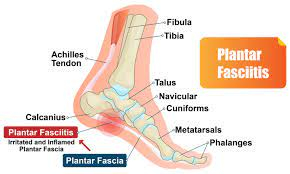



Pain in the heel is one of the common presenting complaints in young adults or middle aged persons. It can also occur in adolescents. The causes of such pain are as follows-
1. Pain in the plantar aspect of the heel Plantar Fasciitis (Calcaneal spur)
2. Pain in the posterior aspect of the heel
a) In adolescents- Osteochondritis of the apophysis of the calcaneum ( Sever's Disease )
b) Tendo Achilles Bursitis in adults (Retro Calcancal Bursitis)
c) Calcification at the Tendo Achilles insertion
3. Pain in the lateral or medial aspect of the heel
a) Old fracture calcaneum
b) Subtaloid arthritis
c) Tumours
d) Infections of the calcaneum
PLANTAR FASCIITIS
Plantar fasciitis is an aseptic inflammation of the plantar fascia. The patient is usually a middle aged adult complaining of pain in one or both heels. Typically this pain is worse in the early morning and the patient is unable to bear weight on the foot on getting up from bed . There may be other associated rheumatoid manifestations like tennis elbow, joint pains or tenosynovitis. There is tenderness on pressure over the medial tuberosity of the calcaneum.
Radiograph of the heel in the lateral view may show varying degrees of the calcaneal spur. The severity of the pain is not proportional to the size of the spur. Even big spurs may be asymptomatic and minimal spurs may be associated with severe pain. The spur is not a growth but a reaction to the local inflammation of the plantar fascia and ligaments with deposition of calcium at the site of the ligamentous attachments.
Local pain may be relieved by addition of a soft foam pad in the heel of the footwear. A course of Ultrasound therapy also is very effective in many cases.
POSTERIOR HEEL PAIN
Pain in the posterior aspect of the heel is a common clinical condition occurring in the middle aged persons. Occasionally it can occur in the adolescents when it is due to osteochondritis of the calcaneal apophysis ( Sever's disease ) . The other causes of pain are-
a) Retrocalcaneal bursitis and
b) Achilles Tendinitis and calcification.
Clinically there will be tenderness on the posterior aspect of the calcaneum. The pain is worse on forcible dorsiflexion of the foot which stretches the tendo achilles. Radiograph may show calcification at the level of insertion of tendo achilles or at the postero superior margin of the calcaneum. In Sever's disease the calcancal apophysis will show increased density and fragmentation.
These conditions respond to raising the heel of footwear by 1.5 cm.
TREATMENT AT DR. SOHAN LAL CLINIC
The integrated POLYCLINIC facility offers patients to select their treatment either from the Department of Homeopathy or from the Department of Medicine.
We provide scientific, research-based, and professional services to people across the world, aiming to achieve the highest success rate.
